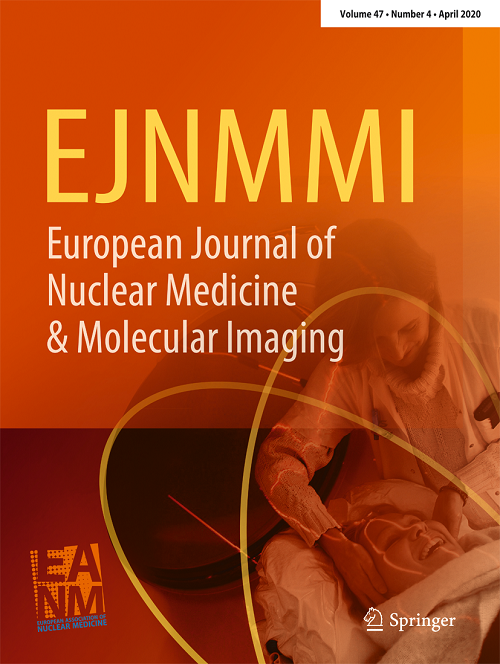使用新型 SSTR 靶向肽 [18F]SiTATE 对分化型甲状腺癌和甲状腺髓样癌进行 PET/CT 成像 - 首次临床经验。
IF 8.6
1区 医学
Q1 RADIOLOGY, NUCLEAR MEDICINE & MEDICAL IMAGING
European Journal of Nuclear Medicine and Molecular Imaging
Pub Date : 2024-10-15
DOI:10.1007/s00259-024-06944-y
引用次数: 0
摘要
目的:新型18F标记的体生长激素受体(SSTR)定向放射性示踪剂[18F]SiTATE在各种SSTR表达的肿瘤类型的成像中表现出良好的效果。虽然甲状腺癌(TC)也表达 SSTR,但目前还缺乏有关[18F]SiTATE PET/CT 在甲状腺癌中成像的数据。本研究探讨了[18F]SiTATE PET/CT在组织学证实的TC患者队列中的应用。方法作为在一家三级癌症中心进行的前瞻性观察研究的一部分,纳入了至少接受过一次[18F]SiTATE PET/CT的21例TC患者(10例髓样(MTC)和11例分化型(DTC))(共37次扫描)。确定了 PET 上肿瘤病灶的平均 SUVmax 和 SUVmean、平均肿瘤总体积 (TTV)、全身 (WB)-SUVmax 和 WB-SUVmean 及其标准差 (SD)。PET 参数与临床参数相关,包括肿瘤标志物水平(DTC 为甲状腺球蛋白,MTC 为降钙素)。转移灶位于骨、淋巴结、肺、软组织和甲状腺床。骨(31 个病灶;SUVmax 8.6 ± 8.0;SUVmean 5.8 ± 5.4)和结节(37 个病灶;SUVmax 8.7 ± 7.8;SUVmean 5.7 ± 5.4)转移灶的摄取量最高。PET 上的 MTC 疾病负荷与降钙素肿瘤标志物水平有明显相关性(如 TTV:r = 0.771,r2 = 0.594,p = 0.002)。结论我们的数据表明,[18F]SiTATE PET/CT 在一小批 MTC 和 DTC 患者中具有很高的可行性。使用[18F]SiTATE可以克服基于68Ga的示踪剂在后勤方面的缺点,促进甲状腺癌的SSTR靶向PET/CT成像。本文章由计算机程序翻译,如有差异,请以英文原文为准。
PET/CT imaging of differentiated and medullary thyroid carcinoma using the novel SSTR-targeting peptide [18F]SiTATE - first clinical experiences.
PURPOSE
The novel 18F-labeled somatostatin receptor (SSTR)-directed radiotracer [18F]SiTATE demonstrated promising results for the imaging of various SSTR-expressing tumor types. Although thyroid carcinomas (TC) express SSTR, data on [18F]SiTATE PET/CT imaging in TC are lacking. This study explores the use of [18F]SiTATE PET/CT in a patient cohort with histologically proven TC.
METHODS
As part of a prospective observational study at a single tertiary cancer center, 21 patients with TC (10 medullary (MTC) and 11 differentiated (DTC)) who underwent at least one [18F]SiTATE PET/CT were included (37 scans in total). Mean SUVmax and SUVmean of tumoral lesions, mean total-tumor-volume (TTV), and whole-body (WB)-SUVmax and WB-SUVmean on PET with their standard deviations (SDs) were determined. PET parameters were correlated to clinical parameters including tumor marker levels (thyroglobulin for DTC, calcitonin for MTC).
RESULTS
89 lesions were included in the analysis. Metastases were localized in the bone, lymph nodes, lung, soft tissue, and thyroid bed. Osseous (31 lesions; SUVmax 8.6 ± 8.0; SUVmean 5.8 ± 5.4) and nodal (37 lesions; SUVmax 8.7 ± 7.8; SUVmean 5.7 ± 5.4) metastases showed the highest uptake. The MTC disease burden on PET significantly correlated with the calcitonin tumor marker level (e.g., TTV: r = 0.771, r2 = 0.594, p = 0.002). For DTC, no such correlation was present.
CONCLUSION
Our data demonstrate high feasibility of [18F]SiTATE PET/CT in a small cohort of patients with MTC and DTC. The use of [18F]SiTATE may overcome logistical disadvantages of 68Ga-based tracers and facilitate SSTR-targeted PET/CT imaging of thyroid carcinoma.
求助全文
通过发布文献求助,成功后即可免费获取论文全文。
去求助
来源期刊
CiteScore
15.60
自引率
9.90%
发文量
392
审稿时长
3 months
期刊介绍:
The European Journal of Nuclear Medicine and Molecular Imaging serves as a platform for the exchange of clinical and scientific information within nuclear medicine and related professions. It welcomes international submissions from professionals involved in the functional, metabolic, and molecular investigation of diseases. The journal's coverage spans physics, dosimetry, radiation biology, radiochemistry, and pharmacy, providing high-quality peer review by experts in the field. Known for highly cited and downloaded articles, it ensures global visibility for research work and is part of the EJNMMI journal family.

 求助内容:
求助内容: 应助结果提醒方式:
应助结果提醒方式:


